

Bucranium (pl. bucrania; from Latin būcrānium, from Ancient Greek βουκράνιον (boukránion) 'ox's head', referring to the skull of an ox) was a form of carved decoration commonly used in Classical architecture. The name is generally considered to originate with the practice of displaying garlanded, sacrificial oxen, whose heads were displayed on the walls of temples, a practice dating back to the sophisticated Neolithic site of Çatalhöyük in eastern Anatolia, where cattle skulls were overlaid with white plaster.
Etymology and sphere of application
The word "bucranium" (latin bucranium) comes from Ancient Greek: βουκράνιον – being composed of βοῦς (ox) and κρανίον (skull) – and literally means "ox skull". Analogic, the Greek word αἰγικράνιον (latin aegicranium) means a "goat skull", also used as a decorative element in architecture.
The technical term "bucranium" was originally used in the description of classical architecture. Its application to the field of prehistoric archeology is relatively recent and is mainly due to the work of the British archaeologist James Mellaart dedicated to the Neolithic site of Çatalhöyük. In 1977, Glyn Daniel established this new meaning of the term, introducing it into the Illustrated Encyclopedia of Archeology.
Overview
In ancient Rome, bucrania were frequently used as metopes between the triglyphs on the friezes of temples designed with the Doric order of architecture. They were also used in bas-relief or painted decor to adorn marble altars, often draped or decorated with garlands of fruit or flowers, many of which have survived.
A rich and festive Doric order was employed at the Basilica Aemilia on the Roman Forum; enough of it was standing for Giuliano da Sangallo to make a drawing, c 1520, reconstructing the facade (Codex Vaticano Barberiniano Latino 4424); the alternation of the shallow libation dishes called paterae with bucrania in the metopes reinforced the solemn sacrificial theme.
While the presence of bucrania was typically used with the Doric order, the Romans were not strict about this. In a first-century fresco from Boscoreale, protected by the eruption of Mount Vesuvius and now at the Metropolitan Museum of Art, bucrania and cistae mysticae hang on ribbons from pegs that support garlands, evoking joyous fasti. At the Temple of Vesta, Tivoli, designed using the Corinthian order, motifs interpreted by the architect Andrea Palladio as conventional skull bucrania adorn the frieze, although these are actually fleshed ox heads with eyes. Similarly, the Temple of Portunus in Rome, designed using the Ionic order, has bucrania in its frieze.
In later years, the motif was used to embellish buildings of the Renaissance, Baroque, and Neoclassical periods. Garlanded bucrania provide a repetitive motif in the plasterwork of the fine 18th-century Staircase Hall of The Vyne (Hampshire), inside the Pantheon at Stourhead (Wiltshire) and at Lacock Abbey (Wiltshire).
Gallery
-
 Neolithic bucrania from Çatalhöyük, 7500-6400 BC, Museum of Anatolian Civilizations, Ankara, Turkey
Neolithic bucrania from Çatalhöyük, 7500-6400 BC, Museum of Anatolian Civilizations, Ankara, Turkey
-
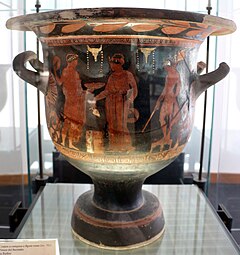 Ancient Greek bucrania on a bell krater from Rudiae with an offering scene, by the Bucranium Painter, c.375-350 BC, ceramic, Museo archeologico Sigismondo Castromediano, Lecce, Italy
Ancient Greek bucrania on a bell krater from Rudiae with an offering scene, by the Bucranium Painter, c.375-350 BC, ceramic, Museo archeologico Sigismondo Castromediano, Lecce, Italy
-
 Ancient Greek bucrania with festoons on a relief with Hermes, Athena, Apollo and Artemis, 125-100 BC, marble, Archaeological Museum of Delos, Delos, Greece
Ancient Greek bucrania with festoons on a relief with Hermes, Athena, Apollo and Artemis, 125-100 BC, marble, Archaeological Museum of Delos, Delos, Greece
-
 Ancient Greek bucrania on a cylindrical funerary altar, 2nd-1st centuries BC, Lartian stone, Archaeological Museum of Rhodes, Rhodes, Greece
Ancient Greek bucrania on a cylindrical funerary altar, 2nd-1st centuries BC, Lartian stone, Archaeological Museum of Rhodes, Rhodes, Greece
-
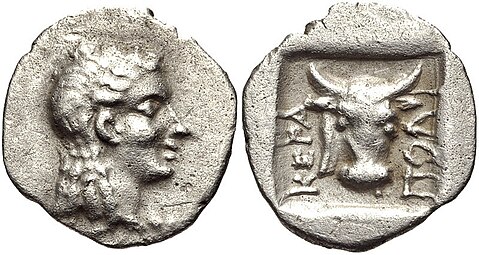 Ancient Greek obol from Ceramus, with the head of the god Apollo and a bucranium, 2 BC, probably silver, unknown location
Ancient Greek obol from Ceramus, with the head of the god Apollo and a bucranium, 2 BC, probably silver, unknown location
-
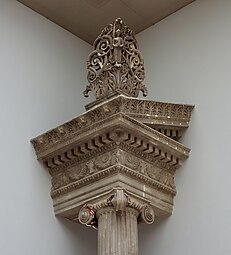 Roman bucrania on an entablature of the Trajaneum from Pergamon, Pergamon Museum, Berlin, unknown architect or sculptor, c.30 AD
Roman bucrania on an entablature of the Trajaneum from Pergamon, Pergamon Museum, Berlin, unknown architect or sculptor, c.30 AD
-
 Roman bucranium on a frieze of the Temple of Vespasian and Titus, Rome, unknown architect, 79-c.87
Roman bucranium on a frieze of the Temple of Vespasian and Titus, Rome, unknown architect, 79-c.87
-
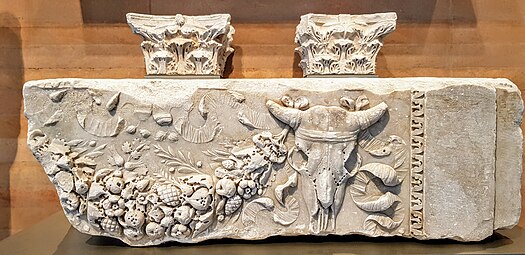 Roman bucranium with a festoon and ribbons, unknown architect, late 1st century, marble, Narbo Via Museum, Narbonne, France
Roman bucranium with a festoon and ribbons, unknown architect, late 1st century, marble, Narbo Via Museum, Narbonne, France
-
Roman bucrania on an urn with funerary inscription, 2nd-3rd century, probably marble, Villa Corsini a Castello, near Florence, Italy
-
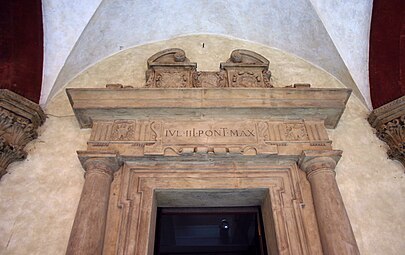 Renaissance bucrania on an entablature of the Palazzo d'Accursio, Bologna, Italy, designed by Fioravante Fioravanti, 15th century
Renaissance bucrania on an entablature of the Palazzo d'Accursio, Bologna, Italy, designed by Fioravante Fioravanti, 15th century
-
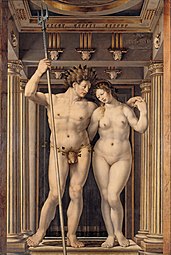 Renaissance bucrania in Neptune and Amphitrite, by Jan Gossaert, 1516, oil on panel, Gemäldegalerie, Berlin
Renaissance bucrania in Neptune and Amphitrite, by Jan Gossaert, 1516, oil on panel, Gemäldegalerie, Berlin
-
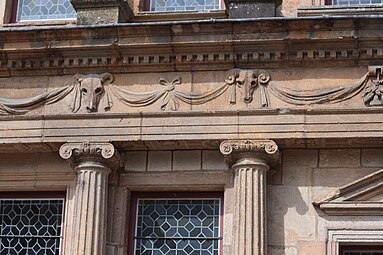 Renaissance bucrania in a frieze on Rue du Cardinal-Morlot no. 20, Langres, France, unknown architect or sculptor, c.1550
Renaissance bucrania in a frieze on Rue du Cardinal-Morlot no. 20, Langres, France, unknown architect or sculptor, c.1550
-
 Renaissance bucrania in a frieze of the Palazzo Budini Gattai, Florence, designed by Giuliano di Baccio d'Agnolo and Bartolomeo Ammannati, 1563-1574
Renaissance bucrania in a frieze of the Palazzo Budini Gattai, Florence, designed by Giuliano di Baccio d'Agnolo and Bartolomeo Ammannati, 1563-1574
-
 Baroque bucranium with a festoon on a corbel of the Hôtel d'Almeyras (Rue des Francs-Bourgeois no. 30), Paris, unknown architect, 17th century
Baroque bucranium with a festoon on a corbel of the Hôtel d'Almeyras (Rue des Francs-Bourgeois no. 30), Paris, unknown architect, 17th century
-
 Rococo bucrania on the foot of a potpurri vase, by Jean-Pierre Ador, 1768, multicoloured gold, en plein and basse-taille enamel, Walters Art Museum, Baltimore, US
Rococo bucrania on the foot of a potpurri vase, by Jean-Pierre Ador, 1768, multicoloured gold, en plein and basse-taille enamel, Walters Art Museum, Baltimore, US
-
 Neoclassical bucrania on the Tomb of Dante, Ravenna, Italy, by Camillo Morigia, 1780-1781
Neoclassical bucrania on the Tomb of Dante, Ravenna, Italy, by Camillo Morigia, 1780-1781
-
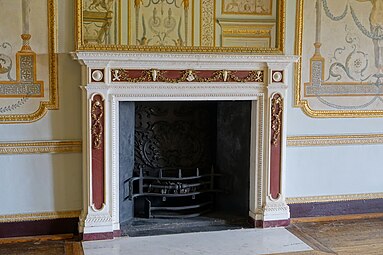 Neoclassical bucrania on the fireplace from the Music Room of the Stowe House, Stowe, Buckinghamshire, UK, by Vincenzo Valdrè, early 1780s
Neoclassical bucrania on the fireplace from the Music Room of the Stowe House, Stowe, Buckinghamshire, UK, by Vincenzo Valdrè, early 1780s
-
 Neoclassical bucrania on a gueridon (small high table) from the salon of madame Récamier, c.1790, mahogany, gilt bronze and marble, Louvre
Neoclassical bucrania on a gueridon (small high table) from the salon of madame Récamier, c.1790, mahogany, gilt bronze and marble, Louvre
-
 Neoclassical bucrania in the Townley Hall, Tullyallen, County Louth, Republic of Ireland, designed by Francis Johnston, 1794-1798
Neoclassical bucrania in the Townley Hall, Tullyallen, County Louth, Republic of Ireland, designed by Francis Johnston, 1794-1798
-
 Neoclassical bucrania on the City Market, Charleston, South Carolina, US, by Edward Brickell White, 1841
Neoclassical bucrania on the City Market, Charleston, South Carolina, US, by Edward Brickell White, 1841
-
 Neoclassical bucrania on a vase design, 19th century, pen and ink, brush and wash on paper, Cooper Hewitt, Smithsonian Design Museum, New York City
Neoclassical bucrania on a vase design, 19th century, pen and ink, brush and wash on paper, Cooper Hewitt, Smithsonian Design Museum, New York City
-
 Art Nouveau bucranium on the facade of the Hôtel Élysée Palace, Paris, architect Georges Chedanne and sculptor Paul Gasq, 1897-1899
Art Nouveau bucranium on the facade of the Hôtel Élysée Palace, Paris, architect Georges Chedanne and sculptor Paul Gasq, 1897-1899
-
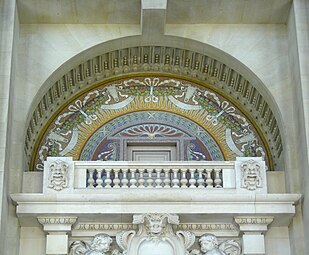 Beaux-Arts mosaic of bucrania and festoons on the Grand Palais, Paris, by Charles Girault, 1897-1900
Beaux-Arts mosaic of bucrania and festoons on the Grand Palais, Paris, by Charles Girault, 1897-1900
-
 Beaux-Arts bucrania on an urn of the Gheorghe Grigore Cantacuzino Palace, Bucharest, Romania, 1898–1906, by Ion D. Berindey
Beaux-Arts bucrania on an urn of the Gheorghe Grigore Cantacuzino Palace, Bucharest, Romania, 1898–1906, by Ion D. Berindey
-
American reinterpretation of the bucranium inspired by Pre-Columbian art on The Cliff Dwelling (Riverside Drive no. 243), New York City, designed by Herman Lee Meader, 1914-1916
-
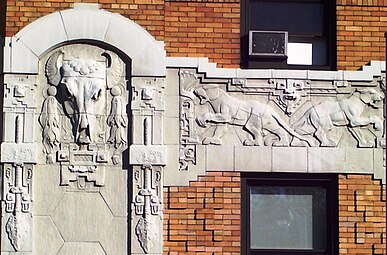 Another American reinterpretation of the bucranium inspired by Pre-Columbian art on The Cliff Dwelling
Another American reinterpretation of the bucranium inspired by Pre-Columbian art on The Cliff Dwelling
-
 Art Deco bucrania of Boulevard Flandrin no. 46, Paris, unknown architect, c.1920
Art Deco bucrania of Boulevard Flandrin no. 46, Paris, unknown architect, c.1920
-
 Art Deco styled bucranium on the Lincoln Bank Tower (East Berry Street no. 116), Fort Wayne, Indiana, USA, designed by Alvin M. Strauss, 1930
Art Deco styled bucranium on the Lincoln Bank Tower (East Berry Street no. 116), Fort Wayne, Indiana, USA, designed by Alvin M. Strauss, 1930
See also
Notes
- Marcel D. Popa et al., Dicționar enciclopedic, Editura Enciclopedică, București, 1993–2009, s.v. „bucraniu”.
- James Stevens Curl, Dictionary of Architecture, Oxford Press, 1999, ISBN 9780198606789, s.v. „aegicrane”.
- James Mellaart, Çatalhöyük. A Neolithic Town in Anatolia, London, 1967.
- Glyn Daniel (ed.), The Illustrated Encyclopedia of Archaeology, Crowell, New York NY 1977, ISBN 0-690-01473-2.
- Loth, Calder, "CLASSICAL COMMENTS: CAN WE TRUST PALLADIO? Antoine Desgodetz Details Palladio’s Inaccuracies" Archived 2014-07-02 at the Wayback Machine, Institute of Classical Architecture & Art, The Classicist Blog
- Loth, Calder, "CLASSICAL COMMENTS: Bucrania" Archived 2013-11-14 at the Wayback Machine, Institute of Classical Architecture & Art, The Classicist Blog
- See Loth "Bucrania" for many more examples
- Fabergé and the Russian Crafts Tradition - An Empire's Legacy. Thames & Hudson. 2017. p. 97. ISBN 978-0-500-48022-9.
- "Guéridon décoré de têtes de bélier, d'une paire avec OA 5231 BIS". collections.louvre.fr. Retrieved 17 October 2023.
References
- Francis Brenders, "The Basilica Aemilia on the Forum Romanum at Rome Archived 2014-03-16 at the Wayback Machine
- Garlanded bucrania on the Ara Pacis
- Sir William Chambers, A Treatise on the Decorative Part of Civil Architecture, 1791 : Doric order with bucrania between triglyphs
- Garlanded bucrania on the Tomb of Cecelia Metella
- Sylloge Nummorum Gracorum: Rubi: obols with garlanded bucrania on reverse
Further reading
- George Hersey (1988). The Lost Meaning of Classical Architecture: Speculations on Ornament from Vitruvius to Venturi. Cambridge, Mass.: MIT Press. Chapter 2: "Architecture and Sacrifice".
External links
- [REDACTED] Media related to Bucrania at Wikimedia Commons
